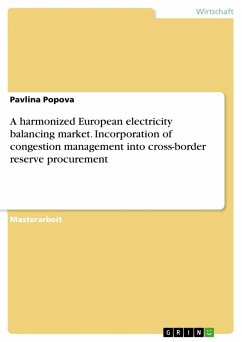Masterarbeit aus dem Jahr 2017 im Fachbereich VWL - Sonstiges, Note: 1,7, Humboldt-Universität zu Berlin (Chair for Management Science), Sprache: Deutsch, Abstract: The thesis is structured as follows. Section 2 gives an overview of the current electricity market design and Section 3 integrates the balancing market in the framework and presents the economical and technical conditions, including the relevant design variables. Section 4 describes the benefits from cross-border coordination in reserve markets and introduces possible integration models. Within Section 5, model requirements are formulated and one suitable model is selected. Section 6 presents the selected methodology and Section 7 gives the obtained case study. Section 8 evaluates the model and discusses the proposed expansion involving the flow-based approach. Lastly, Section 9 concludes and gives further research prospects.
European electricity markets have changed profoundly in the last decades. In national markets increased deregulation and privatization have accompanied the decoupling of transmission, distribution and generation activities. Simultaneously, markets in Europe are becoming more interconnected and harmonized. Until now, the focus was primarily set on the harmonization and integration of spot and forward markets. Nonetheless, the short-term regulation of flexible short-term operating reserves within the balancing market is gaining attention in academia and industry, especially due to the increased penetration of intermitted renewables, which leads to more short-term deviation in the power grid and hence to operational uncertainty.
Corresponding to the zonal nature of the European power market, today's operating reserve markets are mainly organized on a national level. Within a European cross-border balancing market, however, Transmission System Operators could coordinate their balancing activities with other control areas. Such cross-border balancing markets increase social welfare and operational reliability, since the amount of reserves required could be decreased through spatial smoothing of imbalances and the costs of reserve procurement and activation can be reduced.
Nevertheless, cross-border reserve markets are constrained by the available cross-border transmission capacity. Therefore, a challenging issue is to account properly for network constraints, especially within the procurement of reserves, which happens before real-time and under uncertainty as neither the remaining cross-border capacity nor the activation status of the procured reserves is known.
Hinweis: Dieser Artikel kann nur an eine deutsche Lieferadresse ausgeliefert werden.
European electricity markets have changed profoundly in the last decades. In national markets increased deregulation and privatization have accompanied the decoupling of transmission, distribution and generation activities. Simultaneously, markets in Europe are becoming more interconnected and harmonized. Until now, the focus was primarily set on the harmonization and integration of spot and forward markets. Nonetheless, the short-term regulation of flexible short-term operating reserves within the balancing market is gaining attention in academia and industry, especially due to the increased penetration of intermitted renewables, which leads to more short-term deviation in the power grid and hence to operational uncertainty.
Corresponding to the zonal nature of the European power market, today's operating reserve markets are mainly organized on a national level. Within a European cross-border balancing market, however, Transmission System Operators could coordinate their balancing activities with other control areas. Such cross-border balancing markets increase social welfare and operational reliability, since the amount of reserves required could be decreased through spatial smoothing of imbalances and the costs of reserve procurement and activation can be reduced.
Nevertheless, cross-border reserve markets are constrained by the available cross-border transmission capacity. Therefore, a challenging issue is to account properly for network constraints, especially within the procurement of reserves, which happens before real-time and under uncertainty as neither the remaining cross-border capacity nor the activation status of the procured reserves is known.
Hinweis: Dieser Artikel kann nur an eine deutsche Lieferadresse ausgeliefert werden.








